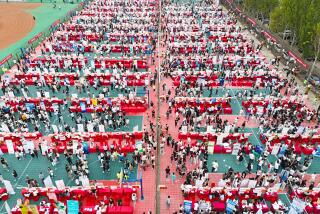The Myth of China’s Middle Class
- Share via
BEIJING — BEIJING -- If you believe the advertisements portraying China’s middle class, you might think that their spacious and modern homes and polished white teeth are representative of this rapidly changing nation.
But experts warn that Chinese and foreign media have constructed a far bigger myth: that China’s middle class is an emerging force and that its demands for participation could push the Communist Party toward political reform.
“China’s middle class is an academic bubble,” scoffed He Qinglian, a Chinese economist living in the U.S. She dismisses the middle class’ political demands as insignificant because “the middle class has developed through reliance on the rich and powerful classes.”
The concept of class remains an ideological minefield in this nominally communist country. Just as sensitive is the perception held by many ordinary Chinese that the spoils of modernization have gone to a privileged few.
“The people who’ve prospered from the reforms are those with power and connections,” said Zhang, an unemployed worker who asked that his full name not be used.
Had things gone differently, Zhang, 42, might have joined the middle class. He worked for a state-owned factory in Beijing from 1980 to 1990 but was laid off when his company farmed work out to rural factories.
Now Zhang peddles postcards and Mao Tse-tung’s Little Red Book of quotations to tourists outside the Forbidden City by day. At night, he retires to the shack he built on the property of his parents’ employers.
“It’s just too hard. You’re working one day and unemployed the next,” he said. “Ordinary people have no feeling of security or stability.”
Qinghua University sociologist Sun Liping sees in people like Zhang a failed middle class. In an essay on the Internet, he warns of a “fractured society” in which people in the same country live in different technological ages.
While “the advanced sectors of this backward nation are becoming more advanced, the distance between these sectors and the rest of society is growing larger,” he says.
By most estimates, China’s middle class represents a negligible bulge in the country’s income distribution. A study by the Chinese Academy of Social Sciences, or CASS, this year estimated China’s middle class at about 110 million -- just 15% of the working population -- compared with nearly 60% in the U.S.
In developed countries where the middle class is statistically dominant, a graph of overall income distribution appears roughly football-shaped, with a fat middle and tapered ends. China’s income distribution, analysts say, is like a pyramid tipped on its side: as the rich get richer, the pyramid’s spire grows longer, and as reforms throw more people out of work, the pyramid’s base expands upward.
According to the CASS study, the middle class itself is pyramid-shaped. The study found that the upper middle class, middle middle class and lower middle class make up 18%, 37% and 45% of the overall class respectively.
Sociologist Zhang Wanli wrote in the study that if the trend continues, China’s middle class could “go the way of the ‘national bourgeoisie,’ ” the former middle class that was torn apart in the wake of the Communist Revolution.
Zhang argues that China’s middle class lacks a clear identity and values and that its boundaries are difficult to define. Many Chinese, she observes, cannot differentiate the middle class from the country’s elites.
Analysts are not ruling out that the middle class will someday achieve a critical mass in China. Anyone living in a major Chinese city can be dazzled by the neon lights, slick ads and cell phone-chattering throngs into believing that China’s middle class is already dominant.
China’s leadership, meanwhile, has noted the scholars’ warnings and apparently realizes that, in the short term, the threat of income disparities will outweigh any threat from the middle class.
“Bearing in mind the objective of common prosperity,” President Jiang Zemin said last month, “we should try to raise the proportion of the middle-income group and increase the income of the low-income group.”
More to Read
Sign up for Essential California
The most important California stories and recommendations in your inbox every morning.
You may occasionally receive promotional content from the Los Angeles Times.










